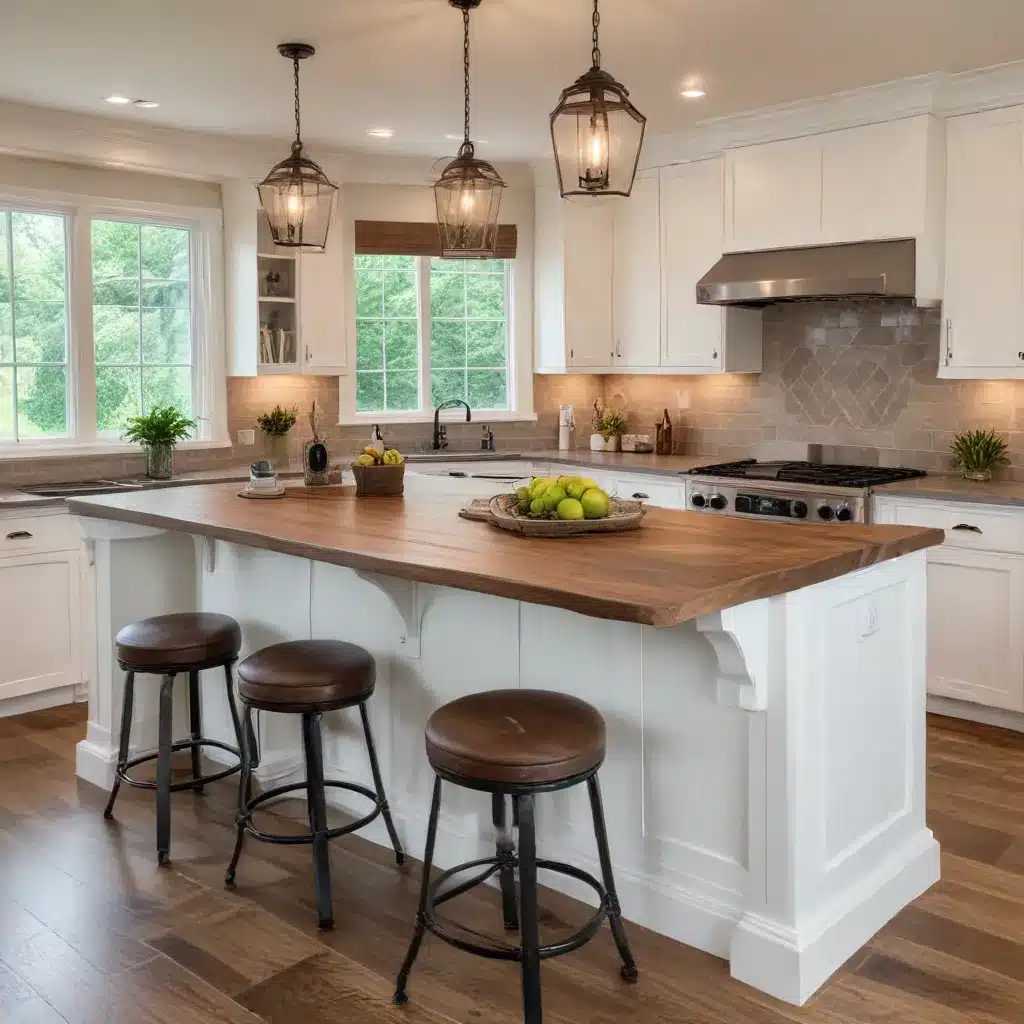
Kitchen Islands: Designing the Heart of the Home
The kitchen island has become the undisputed centerpiece of modern kitchen design. As the functional and social hub of the home, a well-designed kitchen island can transform the entire space, elevating both form and function. Whether you’re undertaking a full kitchen renovation or simply looking to update your existing layout, thoughtfully incorporating a kitchen island can breathe new life into this crucial gathering place.
Maximizing Kitchen Space
For homeowners dealing with limited square footage, the kitchen island can be a game-changer in maximizing usable space. Small and basic islands measuring as little as 24 inches wide can still provide crucial additional work surface and storage without overwhelming the room. Alternatively, one-sided bar configurations with a generous 12- to 18-inch overhang allow for seating along one edge, freeing up the opposite side for cooking and prep work.
In larger kitchens, open-ended islands offer seating on three sides, fostering a more convivial atmosphere ideal for socializing while you cook. This layout is especially well-suited when the primary work zones (sink, stove, refrigerator) are concentrated on one wall, leaving the island as a dedicated dining and gathering space.
Regardless of your kitchen’s dimensions, strategic planning is key to ensuring your island serves its intended purpose. Utility-focused islands incorporate sinks, cooktops, or other appliances, streamlining workflow, but require thoughtful placement to avoid obstructing foot traffic or limiting seating options.
Storage Solutions
Beyond its role as an additional work surface, the kitchen island presents a prime opportunity to incorporate valuable storage. Outfitting your island with pullout trash/recycling drawers, book shelves, or even a wine cooler or beverage fridge can help declutter the main kitchen countertops and cabinets.
Two-sided access to the island’s base cabinetry can maximize storage capacity, though this approach requires a larger footprint. For smaller islands, even simple furniture pieces like a butcher block stand or island cart can provide a welcome boost in storage and surface area.
Integrating Appliances
While not every kitchen can accommodate a sink or cooktop within the island, there are creative ways to integrate appliances for enhanced functionality. Slide-in ranges or built-in cooktops embedded in the island’s countertop offer a sleek, uninterrupted work surface while maintaining easy access for the cook.
Positioning the island’s sink facing outward, rather than inward toward the primary prep zone, can be a practical solution for homeowners who prefer to engage with guests or family members while washing dishes. This configuration also allows the island to double as a casual dining spot.
Material Choices
The countertop material you select for your kitchen island can have a significant impact on both the aesthetics and durability of the space. Quartz, for example, is a popular choice for its non-porous, low-maintenance properties, as well as its ability to mimic the look of natural stone with consistent patterns and colors.
Alternatively, natural stone like marble or soapstone can lend a timeless, high-end feel, though homeowners should be mindful of their maintenance requirements. Designers often opt for a honed or matte finish to achieve a softer, less shiny appearance.
Solid wood islands, particularly in materials like rift-sawn oak, can also be a stunning focal point, showcasing the natural grain and texture of the wood. These custom-stained islands are durable, versatile, and can be designed to seamlessly integrate with the surrounding cabinetry.
Aesthetic Considerations
While the island’s functionality is paramount, its visual impact should not be overlooked. Choosing complementary finishes for the island cabinetry, hardware, and lighting can elevate the entire kitchen design.
A farmhouse-inspired aesthetic might feature a white-painted island base with brass hardware and a rustic, wide-plank hardwood top. Alternatively, a modern or industrial-influenced kitchen may benefit from a dark-stained or graphite-hued island base paired with unlacquered brass faucets and fixtures.
Pendants and chandeliers suspended over the island can also be a striking design element, adding both task lighting and a statement-making focal point. Linear chandeliers, globe pendants, or minimalist sconces are all popular choices that can enhance the island’s visual appeal.
Optimizing Workflow
Ergonomics and workflow are essential considerations when designing a kitchen island. Ensuring the countertop height is comfortable for both standing and seated tasks can improve efficiency and reduce strain. A standard 36-inch height is typical, but a slightly lower 34-inch surface may be more suitable for those who prefer to work while seated.
Incorporating seating into the island design, whether in the form of barstools or a dining-height overhang, can transform the space into a multifunctional hub for casual meals, homework, or socializing. When planning seating, aim for a 12- to 18-inch overhang to accommodate comfortable leg room.
Thoughtful island placement is also crucial for maintaining a smooth flow of foot traffic through the kitchen. Positioning the island to allow for unobstructed access to the primary work zones and doorways can enhance the overall efficiency of the space.
Trends and Innovations
As the kitchen island’s role in the home continues to evolve, new design trends and technological innovations are emerging to meet the changing needs of modern homeowners. Multifunctional islands that seamlessly integrate features like charging stations, smart home controls, or even pop-up electrical outlets are becoming increasingly popular.
Sustainable design is also gaining traction, with eco-friendly materials like reclaimed wood, recycled glass, or VOC-free finishes gaining favor among environmentally conscious renovators. These options not only reduce the island’s environmental impact but can also contribute to a unique, one-of-a-kind aesthetic.
Whether your goal is to create a cozy, family-friendly gathering space or a sleek, modern culinary command center, the kitchen island offers endless possibilities for customization and innovation. By thoughtfully considering its functionality, style, and integration within the overall kitchen design, you can transform this central hub into the true heart of your home.
For more inspiration and expert advice on kitchen renovations, be sure to explore the wealth of resources available on Reluctant Renovator. From budgeting tips to eco-friendly solutions, this comprehensive website is a must-visit for anyone embarking on a kitchen remodel.



